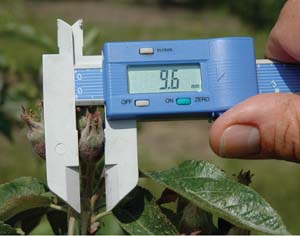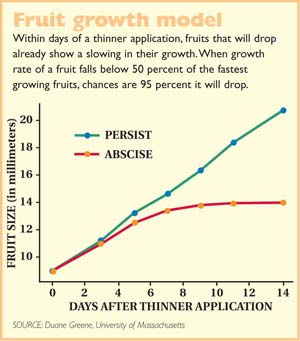To evaluate thinning effectiveness using the “fruitlet model,” individual apples must be labeled and measured two or three times to assess their rate of growth.
While chemical fruit thinners can work fairly well on apples, the thinning effect is variable year to year.
Growers are reluctant to make repeated thinner applications without knowing if the original application was effective and how many apples are going to persist on the tree. This natural hesitancy often results in the need for further thinning by hand, an expensive proposition.
“It would be very useful to be able to accurately assess thinning response,” said University of Massachusetts researcher Dr. Duane Greene. “Unfortunately, we have not had a system in place that would allow orchardists to assess the crop load potential and to determine the effectiveness of thinning treatment in time to make a second thinner application during the thinning window of opportunity.”
However, Greene says there is a way for growers to accurately predict which and how many fruitlets will fall off due to the thinning chemical and make the assessment within seven to ten days after thinner application, when the fruitlets are still small enough to make additional thinner applications.
Fruitlet model
During an educational session of the International Fruit Tree Association in Grand Rapids, Michigan, in March, he explained what he calls the “fruitlet model” for predicting final set after a thinner has been applied.
The model assumes that fruitlets that will persist after a chemical thinning spray will continue to grow rapidly through the June drop period, whereas those fruit that will drop will slow their growth and eventually stop growing and drop off, he said. “Regardless of the mode of action of a thinner, a reduction in growth rate precedes abscission, and sometimes this occurs as much as two or more weeks in advance.
“Thinning predictions from 13 experiments over four years confirmed that a prediction can be made within seven to ten days with near 95 percent accuracy if 130 to 140 heating degree units (base 50°F) have been accumulated after the thinner application.
“We followed the growth rate of thousands of fruit, and slow fruit growth is highly correlated with fruit abscission. Rapid fruit growth is highly correlated with fruit set.”
The idea, then, is to measure the diameter of fruitlets on the tree at intervals. Those growing at less than half the rate of the fastest growing fruitlets will drop off. The fastest growing fruits are the standard against which to measure others.
Procedure
- Select 10 to 20 spurs per tree on five to ten trees (for a total of 100 spurs) and tag them before applying the thinner.
- Mark and identify individual fruits on each tagged spur. The fruits will be small, but Greene used a permanent marker to write a number on each fruitlet.
- It generally requires at least four days after thinner application to note growth reduction on fruit destined to abscise. In cool years, this could take up to seven days.
- Using a caliper (a digital readout is handy), measure each fruitlet, starting no earlier than when it reaches 6 to 7 millimeters diameter and record each fruit’s size.
- Measure fruit at two- or three-day intervals and record measurements. As few as two measurements may be enough; one starting at four days after application and another three to four days later.
- Predict which fruitlets will drop off—those failing to grow at least half as fast as the fastest growing.
An accurate prediction can normally be made within seven days of application, Greene said, which allows time for a grower to make repeat applications since the fruit is still small enough to respond to thinners.
He suggests that, before starting, growers set a goal of how many fruit they’d like to see on the tree. If you want to set one fruit for each two spurs, and each spur has four fruitlets, you want 88 percent of the fruit to be gone after the thinning process.
 Growers can find help in this procedure by going to the Web site www.umass.edu/fruitadvisor. In the address line, type in /2008/predictfruitset2008.xls for an Excel spreadsheet that will do calculations for you and /2008/predict thinprocedure.pdf for step-by-step instructions.
Growers can find help in this procedure by going to the Web site www.umass.edu/fruitadvisor. In the address line, type in /2008/predictfruitset2008.xls for an Excel spreadsheet that will do calculations for you and /2008/predict thinprocedure.pdf for step-by-step instructions.
Greene would like to hear back from growers who use the process about how well it worked for them.
Steve McArtney, a fruit-thinning expert from North Carolina State University who spoke during the same IFTA meeting, urged growers to leave a control when trying new thinning strategies:
“Always, always, leave unsprayed trees to test the effect of your thinners. You need to do it, or you won’t know what caused the thinning.”

Leave A Comment